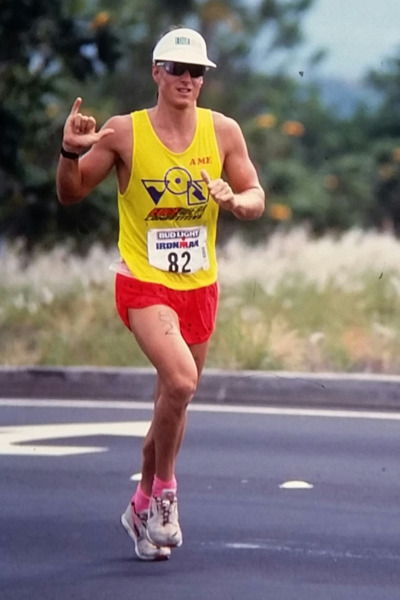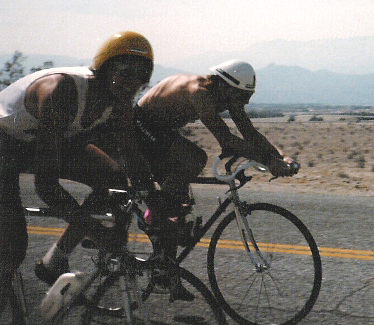 That’s me at the 1989 Hawaii Ironman World Championships, which used to be held annually in Kailua-Kona, Hawaii. My time of 8:57 is still the USA record for 24-and-under age group so I haven’t had to return, thank goodness.
That’s me at the 1989 Hawaii Ironman World Championships, which used to be held annually in Kailua-Kona, Hawaii. My time of 8:57 is still the USA record for 24-and-under age group so I haven’t had to return, thank goodness.
In other triathlon news, I noticed that the Ironman Corporation is looking for a new CEO. We are now talking about a $1 billion company with 600 employees and 235 official events around the world. That’s a long way from the humble beginnings of triathlon in the late ’70s/early ’80s. It’s great to see how triathlon has grown like crazy since my days on the pro circuit (’86-’94), not to mention endurance sports in general. But some of the growth has come at a cost to health and well-being. There are lots of complaints about over-commercialization and the extreme costs of competing, and I object to the romanticization of extreme endurance challenges that are almost certainly unhealthy to attempt by most people. If I were forced to become CEO of The Ironman Group for a stint, here is what I would do:
Cut Ironman distance in half: My day one edict—I hereby officially decree the “Ironman distance” to be 70.3 miles (current half-Ironman). Most people have no business attempting a full Ironman, 70.3 is an incredibly awesome extreme endurance accomplishment. It’s more athletic to set out on a competitive pace and cross the line 4 or 6 hours later than just shuffle along all day to get your M-dot tattoo at the finish line.
Tattoo reparations: I’ll pay everyone who displays an Ironman tattoo the sponsorship stipend they deserve. I hear they have tattoo artists setting up shop at Ironman finish lines so finishers can pay for the privilege of branding a corporate logo onto their bodies. Seems backward? I mean, I’m willing to get a corporate logo tattooed on my body after a great athletic achievement too, but they will have to pay me a million bucks. Swoosh me, baby!
 Ban aerobars: They are too dangerous for bike handling and probably worse for your prostate, shoulders, and lower back than regular bars. (This is coming from the first athlete ever to use aerodynamic handlebars in a multisport event—Desert Princess Duathlon, Feb ’87.)
Ban aerobars: They are too dangerous for bike handling and probably worse for your prostate, shoulders, and lower back than regular bars. (This is coming from the first athlete ever to use aerodynamic handlebars in a multisport event—Desert Princess Duathlon, Feb ’87.)
Ban road cycling: That’s right, all triathlons must take place off-road on dirt or paved bicycle paths. You are risking your life every time you set out for a routine ride, especially in the modern days of mobile phones and giant SUVs. Yes, you can crash on a mountain bike, but you’ll fare better than against vehicles. If you bristle at this warning and consider yourself a safe, skilled rider or have other such rationalizations going, take out a notepad and write down the 10 most dangerous things you do in daily life. I’ll bet road cycling is 100x or 1000x more dangerous than number two, unless you fall trees or mine coal for a living.
As someone who has pedaled over 100,000 miles in my life and lived to tell about it, please take my reflection seriously. When I was a triathlon race director for a decade, I made plenty of hospital visits to riders injured in my race. Pilot error is a common cause of injury and demise, but not always. Someone’s text message could be your ticket to the hospital on your next ride.
 Drug test age groupers: Just kidding! We must make a major effort to test, deter, and penalize drugs in professional sports for sure. If an amateur wants to dope up to win a medal, the planet has worse problems.
Drug test age groupers: Just kidding! We must make a major effort to test, deter, and penalize drugs in professional sports for sure. If an amateur wants to dope up to win a medal, the planet has worse problems.
It’s also interesting to reflect on an idea Mark Sisson has floated for many years that perhaps we should legalize doping amongst elite athletes! Hear this out: We would end the suspicions and unfair advantages; athletes can get the best medical guidance for their protocols; and finally, because it’s actually healthier in every respect to do the Tour de France, professional Ironman racing or elite level marathon/ultramarathon racing while doped, than it is trying to do these crazy events and extreme training while clean.
The public doesn’t understand this assertion well, but the destruction to the body caused by training for 30 hours per week is severe. A top athlete is on the red line at all times, trading longevity and general health for incremental performance gains. If one were to train at the highest level with hematocrit pegged at 50 with EPO, and testosterone pegged at 1,000 or 1,200 ng/ml with hormone replacement, the athlete would perform better, recover faster, experience less free radical damage, and stabilize hormonal, immune, and endocrine functions that are trashed by extreme endurance training.
Speaking of doping, I’m aware of the extreme controversy surrounding transgender athletes participating as females in competition. Clearly it’s a huge advantage to have a different hormonal profile for years prior to competing in the female division. The advantage lingers, just as it does for someone doping for bodybuilding and then going clean for years after—still jacked! Governing bodies must address and legislate these things for Olympic/professional competition. I’m not astute on the subject, but it seems like a separate division is appropriate for those who don’t fall into the traditional profiles.
In the case of amateur sport, it seems trans folks have been marginalized and struggled in so many ways that maybe we don’t need to make a huge fuss over them winning medals and setting records. Most athletic competitions are influenced by genetic gifts anyway, there is no such thing as “fairness” when you have a higher VO2 max thanks in large part to your parents. I’m sure it’s no fun to work hard and get beaten by someone with certain advantages, whether they are secretly doping, live at high altitude, have more free time to train than opponents, or have transitioned. However, sports should be mostly about personal challenge and personal growth, regardless of whether you make the podium or not.








